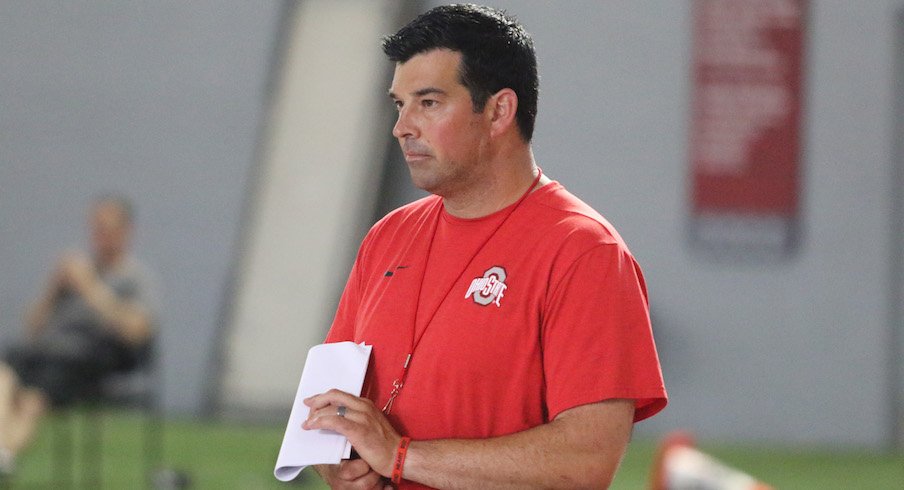In the first year of the NCAA’s transfer portal, Ohio State has already benefited in a big way.
The Buckeyes landed perhaps the most coveted player on this year’s transfer market when Justin Fields chose to transfer to Ohio State from Georgia, and the portal played a part in making that happen. Once Fields entered his name into the transfer portal in December, Ohio State was able to contact him immediately, and it didn’t waste time in doing so, ultimately leading to his enrollment at OSU one month later.
“Once Justin went in the portal, obviously there was communication there,” Ohio State head coach Ryan Day said Wednesday when recalling Fields’ recruitment. “There was interest on his end, interest on our end, and then it kind of went from there.”
Just because the Buckeyes made one big move into the transfer portal, though, doesn’t mean they plan to do so repeatedly.
Transfers have become a bigger part of college football than they have ever been before, so Ohio State recognizes that it needs to adapt accordingly. Day said Wednesday that assistant athletic director of player personnel Mark Pantoni and the rest of Ohio State’s player personnel staff have been checking the transfer portal regularly in search of players who could potentially help the Buckeyes, and he indicated that the Buckeyes could even add staffers to evaluate potential transfers.
“We have to evolve with the times, and to be competitive, we need to be involved with that,” Day said. “So Mark Pantoni has had to make adjustments. He’s had to really stay on top of that transfer portal, and then evaluate who goes into that portal. And it might be one of those things down the road where we have to have to designate part of our recruiting department just towards that.”
At the same time, Day still believes Ohio State’s roster-building priority needs to be recruiting players out of high school so that the coaches can build relationships with them early and develop them from the beginning of their collegiate careers.
“We want to recruit guys when they're freshmen, sophomores, guys who want to be Buckeyes, and build relationships over time,” Day said. “We don't want to rely on (transfers).”
Ohio State didn’t bring in many transfers during Urban Meyer’s seven-year tenure as head coach, and Day isn’t looking to change that drastically. Day doesn’t want to see the transfer portal turn into full-fledged free agency; he said Wednesday that he believes college football teams should be limited to bringing in two scholarship transfers per calendar year, and said he expects there to be discussions about implementing such a rule this spring.
“We want to recruit guys when they're freshmen, sophomores, guys who want to be Buckeyes, and build relationships over time.”– Ryan Day on why recruiting high school players is still Ohio State's priority
So far, Fields is the only transfer that the Buckeyes have brought in this offseason, and the reasons they did that are obvious; Fields is one of the most talented quarterbacks in the country, and the Buckeyes needed to add a starting-caliber quarterback to their roster after losing Dwayne Haskins to the 2019 NFL draft and failing to sign a high school quarterback in their 2019 recruiting class.
Day said Wednesday that Ohio State only plans to pursue transfers who both address an area of need on the roster and are a good fit for the program’s culture.
“We're very, very careful about that,” Day said. “It has to be a need, it has to be a fit. Because we spend a lot of time recruiting these kids ever since they've been freshmen and sophomores, most of them. We bring them into a culture that we really take seriously. So to bring somebody in, has to be a great fit. Justin is a great fit for a lot of reasons, so we're excited about him.”
The Buckeyes aren’t likely to pursue many more transfers this offseason, because they are already at the 85-scholarship limit after losing only two transfers of their own. Tate Martell left for Miami and Keandre Jones left for Maryland (and Brian Snead also left Ohio State, though he had been suspended from the team since last year), but otherwise, the Buckeyes' only departures from their scholarship roster have been seniors and early NFL draft entrants.
If transferring continues to become increasingly commonplace in college football, however, successfully recruiting transfers could become an increasingly important step to being a national contender.
Much like in the NFL, where a team must draft consistently well and develop its young talent in order to be successful even with free agency, Ohio State must recruit top talent every year and develop those players to reach their potential in order to compete for championships, no matter how the transfer portal might ultimately change college football.
But if the Buckeyes need to also pursue transfers each year in order to keep themselves in position to compete at the highest level, they’ll do what they have to do.
“It's ever-evolving. To say I know where it's going to be in two to five years, I don't know that,” Day said. “However, since there's been such a change with this transfer portal, with grad transfers becoming available, we have to be able to adapt and we have to look at those things in order to be competitive. Because at the end of the day, what matters is winning championships.”


